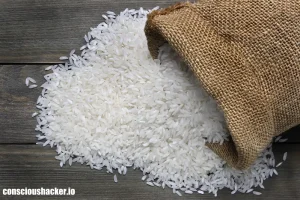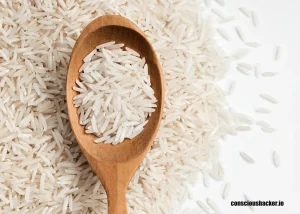Rice is a staple food in many cultures around the world. But have you ever wondered whether rice is a vegetable or a grain? To understand this, let’s go further to know the facts about rice, how to grow them and their benefit for human health.

Is rice a vegetable or rice a grain? Different types of rice
Rice is a cereal grain; it is one of the most widely consumed staple foods in many parts of the world, especially in Asian countries. Rice is one part called the seed of the grass species Oryza sativa or Oryza glaberrima. It is typically categorized as a carbohydrate rather than green vegetable, although it can be considered a starchy vegetable in some cultures.
Classification
Rice technically be considered a vegetable, however
A vegetable is typically classified as part of a plant that humans consume as food. It can be a plant’s root, stem, leaf, or flower. However, when it comes to grains like rice, it doesn’t fit this definition.
Rice is a Grain
Rice would be considered a type of grain category, more specifically, a cereal grain. Rice is a seed of the rice plant and is cultivated for its edible properties. Unlike vegetables, rice is not typically classified as a vegetable because it does not fall under the root, stem, leaf, or flower category.
Types of Rice
There are varieties of rice and different ways to classify rice. Following the shape grain of rice, we have long-grain, medium-grain, and short-grain rice. Under the colour aspect, there are black rice, brown rice, white rice. Each type of rice has its unique characteristics and texture, making it suitable for various dishes like fried rice or sushi rice. However, we will go further about two main types: brown and white rice.
Brown rice is considered a whole grain rice because it retains the bran and germ layers rich in fiber and nutrients. On the other hand, white rice or refined grain, undergoes a refining process that removes the bran and germ, resulting in a more polished appearance and lighter texture.
Due to the refining process, white rice tends to have lower fiber and certain nutrients than brown rice. Brown rice offers more vitamins, minerals, and antioxidants, making it a healthier option overall.
The choice between brown and white rice depends on individual dietary needs and preferences. Brown rice may be healthier than white rice, particularly for those seeking to increase their fiber intake, while white rice may be preferred for its softer texture and milder taste.
Arsenic in Rice
There has been growing concern about arsenic in rice and its potential health risks in recent years.
Arsenic is a naturally occurring element found in the environment, including soil and water. Rice is a type which has a unique ability to absorb arsenic from the ground, leading to its presence in rice grains.
Much rice consumption, especially in regions where it is a dietary staple, can contribute to arsenic exposure. Long-term exposure to high levels of arsenic has been linked to health problems, including an increased risk of certain cancers.
There are several ways to minimize arsenic exposure when consuming rice. These include rinsing rice before cooking, cooking rice with excess water and draining it afterward, and opting for rice varieties known to have lower arsenic levels, such as basmati rice or rice grown in regions with lower arsenic content in the soil.
How to Grow Rice?
If you’re interested in growing rice, it’s essential to understand the rice planting process, cultivating techniques, and harvesting methods.
Rice Planting Process
The first step in growing rice is to prepare the field. Rice is a plant grown in flooded areas, requiring a lot of water. The seeds are then sown directly into the water, germinating and growing into rice plants.
Cultivating Rice
Once the rice plants grow, they require regular maintenance, including water management, weed control, and pest management. Rice cultivation involves techniques like transplanting seedlings or direct seeding, depending on the variety and local practices.
Harvesting Rice
Rice is harvested when the grains are fully mature, the rice falls and turns golden. The harvesting process involves cutting the rice stalks and collecting them for further processing. The harvested rice is then dried and processed to remove the outer husk, resulting in the edible grain.

Nutritional benefits of eating rice healthy
Rice is a good source of carbohydrates and provides essential nutrients like vitamins, minerals, and dietary fiber. It is also low in fat and sodium, making it a healthy meal addition.
In many cultures, rice is considered a staple food, meaning it forms the central part of the diet and provides most calories. It is often served as a side dish or as the base for various dishes, making it a versatile and filling option.
Regular consumption of rice has been associated with several health benefits. It can aid digestion, promote satiety, and provide a steady release of energy. Additionally, certain types of rice, such as brown rice, contain more fiber and nutrients than refined white rice.
Ideal recipes with white rice
Let’s try some ideal recipes by cooking with rice
1. Veggie Fried Rice
Ingredients
– 2 cups of cooked rice (preferably chilled)
– 1 cup of mixed vegetables (carrots, beans and peas, corn, bell pepper, etc.)
– 2 cloves of garlic, minced
– 1 onion, chopped
– 2 tablespoons of soy sauce
– 1 tablespoon of sesame oil
– 2 tablespoons of vegetable oil
– Salt and pepper to taste
– Green onions for garnish
Instructions
1. Heat vegetable oil in a large skillet or wok over medium-high heat.
2. Add the onions, garlic, and mixed vegetables to the skillet and sauté until the veggies are tender-crisp.
3. Push the veggies to one side of the skillet and add chilled rice to the other side.
4. Drizzle sesame oil and soy sauce over the rice and mix well to coat it evenly.
5. Stir-fry for 5-8 minutes, until the rice is heated and well combined with the veggies.
6. Season with salt and pepper to taste, and garnish with green onions before serving.
2. Coconut Curry Rice
Ingredients
– 1 cup of basmati rice (or jasmine rice)
– 1 can of coconut milk
– 1 tablespoon of curry powder
– 1 small onion, finely chopped
– 2 cloves of garlic, minced
– 1 carrot, diced
– 1 bell pepper, sliced
– 1 zucchini, sliced
– 1 cup of frozen peas
– Salt and pepper to taste
– Fresh cilantro for garnish
Instructions
1. Cook the basmati rice according to package instructions and set aside.
2. In a large pot, heat oil and sauté the onion and garlic until translucent.
3. Add the carrots, bell pepper, zucchini, and peas to the pot and cook for a few minutes until slightly tender.
4. Stir in the curry powder and cook for another minute to release the flavors.
5. Add the cooked rice and coconut
